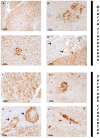Immunolocalization of Two Neurotrophins, NGF and BDNF, in the Pancreas of the South American Sea Lion Otaria flavescens and Bottlenose Dolphin Tursiops truncatus
- PMID: 39199870
- PMCID: PMC11350702
- DOI: 10.3390/ani14162336
Immunolocalization of Two Neurotrophins, NGF and BDNF, in the Pancreas of the South American Sea Lion Otaria flavescens and Bottlenose Dolphin Tursiops truncatus
Abstract
In this study, we have investigated the immunolocalization of NGF (Nerve Growth Factor) and BDNF (Brain-Derived Neurotrophic Factor) in the pancreas of two species of marine mammals: Tursiops truncatus (common bottlenose dolphin), belonging to the order of the Artiodactyla, and Otaria flavescens (South American sea lion), belonging to the order of the Carnivora. Our results demonstrated a significant presence of NGF and BDNF in the pancreas of both species with a wide distribution pattern observed in the exocrine and endocrine components. We identified some differences that can be attributed to the different feeding habits of the two species, which possess a different morphological organization of the digestive system. Altogether, these preliminary observations open new perspectives on the function of neurotrophins and the adaptive mechanisms of marine mammals in the aquatic environment, suggesting potential parallels between the physiology of marine and terrestrial mammals.
Keywords: Brain-Derived Neurotrophic Factor; Nerve Growth Factor; South American sea lion; common bottlenose dolphin; marine mammals; pancreas.
Conflict of interest statement
The authors declare no conflicts of interest.
Figures



Similar articles
-
Expression and immunohistochemical detection of leptin-like peptide in the gastrointestinal tract of the South American sea lion (Otaria flavescens) and the bottlenose dolphin (Tursiops truncatus).Anat Rec (Hoboken). 2012 Sep;295(9):1482-93. doi: 10.1002/ar.22532. Epub 2012 Jul 13. Anat Rec (Hoboken). 2012. PMID: 22791650
-
Serological evidence of Toxoplasma gondii infection in captive marine mammals in Mexico.Vet Parasitol. 2012 Mar 23;184(2-4):321-4. doi: 10.1016/j.vetpar.2011.08.036. Epub 2011 Sep 3. Vet Parasitol. 2012. PMID: 21944844
-
Campylobacter Insulaenigrae: First Isolation Report from South American sea lion (Otaria Flavescens, (Shaw, 1800).Braz J Microbiol. 2011 Jan;42(1):261-5. doi: 10.1590/S1517-83822011000100033. Braz J Microbiol. 2011. PMID: 24031630 Free PMC article.
-
The Gulf of Ambracia's Common Bottlenose Dolphins, Tursiops truncatus: A Highly Dense and yet Threatened Population.Adv Mar Biol. 2016;75:259-296. doi: 10.1016/bs.amb.2016.07.002. Epub 2016 Aug 25. Adv Mar Biol. 2016. PMID: 27770987 Review.
-
An update on the development of a bottlenose dolphin, Tursiops truncatus, immune reagent toolkit.Vet Immunol Immunopathol. 2024 Jun;272:110769. doi: 10.1016/j.vetimm.2024.110769. Epub 2024 Apr 29. Vet Immunol Immunopathol. 2024. PMID: 38703558 Review.
Cited by
-
Assessing Bottlenose Dolphins' (Tursiops truncatus) Health Status Through Functional Muscle Analysis, and Oxidative and Metabolic Stress Evaluation: A Preliminary Study.Animals (Basel). 2025 Apr 25;15(9):1215. doi: 10.3390/ani15091215. Animals (Basel). 2025. PMID: 40362029 Free PMC article.
-
TrkB Receptor Antagonism Enhances Insulin Secretion and Increases Pancreatic Islet Size in Rats Fed a Cafeteria-Style Diet.Biomedicines. 2025 Jan 8;13(1):126. doi: 10.3390/biomedicines13010126. Biomedicines. 2025. PMID: 39857710 Free PMC article.
References
LinkOut - more resources
Full Text Sources

